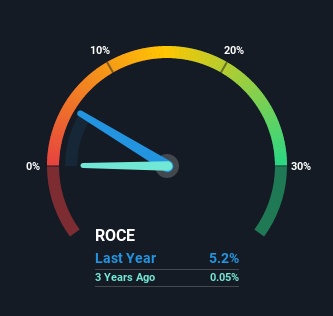- Hong Kong
- /
- Construction
- /
- SEHK:8268
These Return Metrics Don't Make Smart City Development Holdings (HKG:8268) Look Too Strong

Ignoring the stock price of a company, what are the underlying trends that tell us a business is past the growth phase? More often than not, we'll see a declining return on capital employed (ROCE) and a declining amount of capital employed. Basically the company is earning less on its investments and it is also reducing its total assets. So after we looked into Smart City Development Holdings (HKG:8268), the trends above didn't look too great.
Return On Capital Employed (ROCE): What is it?
Just to clarify if you're unsure, ROCE is a metric for evaluating how much pre-tax income (in percentage terms) a company earns on the capital invested in its business. Analysts use this formula to calculate it for Smart City Development Holdings:
Return on Capital Employed = Earnings Before Interest and Tax (EBIT) ÷ (Total Assets - Current Liabilities)
0.052 = HK$6.5m ÷ (HK$325m - HK$200m) (Based on the trailing twelve months to September 2021).
So, Smart City Development Holdings has an ROCE of 5.2%. In absolute terms, that's a low return and it also under-performs the Construction industry average of 8.7%.
View our latest analysis for Smart City Development Holdings

While the past is not representative of the future, it can be helpful to know how a company has performed historically, which is why we have this chart above. If you want to delve into the historical earnings, revenue and cash flow of Smart City Development Holdings, check out these free graphs here.
So How Is Smart City Development Holdings' ROCE Trending?
We are a bit worried about the trend of returns on capital at Smart City Development Holdings. About five years ago, returns on capital were 50%, however they're now substantially lower than that as we saw above. And on the capital employed front, the business is utilizing roughly the same amount of capital as it was back then. Since returns are falling and the business has the same amount of assets employed, this can suggest it's a mature business that hasn't had much growth in the last five years. So because these trends aren't typically conducive to creating a multi-bagger, we wouldn't hold our breath on Smart City Development Holdings becoming one if things continue as they have.
On a separate but related note, it's important to know that Smart City Development Holdings has a current liabilities to total assets ratio of 62%, which we'd consider pretty high. This effectively means that suppliers (or short-term creditors) are funding a large portion of the business, so just be aware that this can introduce some elements of risk. While it's not necessarily a bad thing, it can be beneficial if this ratio is lower.
In Conclusion...
In summary, it's unfortunate that Smart City Development Holdings is generating lower returns from the same amount of capital. It should come as no surprise then that the stock has fallen 36% over the last five years, so it looks like investors are recognizing these changes. That being the case, unless the underlying trends revert to a more positive trajectory, we'd consider looking elsewhere.
Since virtually every company faces some risks, it's worth knowing what they are, and we've spotted 3 warning signs for Smart City Development Holdings (of which 1 can't be ignored!) that you should know about.
For those who like to invest in solid companies, check out this free list of companies with solid balance sheets and high returns on equity.
New: Manage All Your Stock Portfolios in One Place
We've created the ultimate portfolio companion for stock investors, and it's free.
• Connect an unlimited number of Portfolios and see your total in one currency
• Be alerted to new Warning Signs or Risks via email or mobile
• Track the Fair Value of your stocks
Have feedback on this article? Concerned about the content? Get in touch with us directly. Alternatively, email editorial-team (at) simplywallst.com.
This article by Simply Wall St is general in nature. We provide commentary based on historical data and analyst forecasts only using an unbiased methodology and our articles are not intended to be financial advice. It does not constitute a recommendation to buy or sell any stock, and does not take account of your objectives, or your financial situation. We aim to bring you long-term focused analysis driven by fundamental data. Note that our analysis may not factor in the latest price-sensitive company announcements or qualitative material. Simply Wall St has no position in any stocks mentioned.
About SEHK:8268
Smart City Development Holdings
An investment holding company, operates as a contractor in the building industry in Hong Kong, the People’s Republic of China, and Macau.
Adequate balance sheet slight.
Market Insights
Community Narratives


